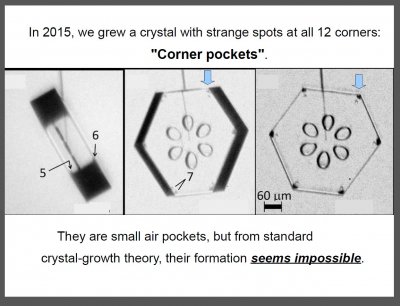| « Dark lines in melting snowpiles | Puddle gets its grooves (upon freezing), part I » |
Poster on corner pockets in snow crystals
Last July, I attended the AMS (American Meteorological Society) 15th Conference on Cloud Physics, which was combined with a similar conference on atmospheric radiation. They have these about every four years, but I have missed all those going back to 1995. So, I had a lot to catch up on. Actually, by far the most enjoyable part of this conference was meeting old colleagues and making new acquaintances, including many who I had known only through their papers and email correspondence. As to why I waited so long, I suppose the main reasons were time and cost. Even without travel and lodging expenses, conferences are expensive. This one was $600, and the fee for the abstract I submitted was an additional $95. But in this case, the conference was only a 3-hr drive away (Vancouver, BC) and my co-worker very nicely picked up the conference fee and hotel tab. Also, this conference had a special session dedicated to the work of my former advisor, Prof. Marcia Baker. In that session, I presented the following poster.
I've described a little about corner pockets in a previous post, and showed a few of these panels before, but will briefly go over them here.
This apparatus is an elaboration of an earlier apparatus I used in Boulder, CO and Tucson, AZ. In those previous experiments, I would occasionally get a crystal that had some interesting feature and sometimes have a crystal that was not obviously affected by the capillary that it grew upon. In these cases, it would have been very nice if I could continue growing the crystal at different temperatures and humidities, getting several data points instead of just one. In that apparatus, the temperature and humidity were related by two vapor-pressure curves and thus not independently controllable. In this apparatus, we could control temperature and humidity independently. (We built in some other useful features as well, but this feature is key for the finding below.) So, we could now keep a "good" crystal or "good" capillary for a range of experiments.
In addition, one crystal could be grown, sublimated, and then regrown, all at the same temperature. When we did such a sequence, we found something unexpected.
The image shows the glass capillary coming down, ending in about the middle of the crystal. The six "seed-looking" features are thin air enclosures. They are interesting and eye-catching, but they are not the feature that captured our attention the most. These are the 12 smaller air enclosures marked by a blue arrow. We called them corner pockets. Prof. Akira Yamashita had found them in a different type of ice crystal a few years before, and even further back in 1974, Teisaku Kobayashi and Takeshi Ohtake had grown a similar crystal under a similar growth->sublimation->growth cycle that revealed the same corner pockets. However, they did not comment on the unusual pockets, focusing their attention on a different feature (which the above crystal also exhibited). Perhaps one reason they did not comment on them is that they seemed 'impossible'. What makes them seem impossible?
As the sketch above shows, the pocket would have to have once been a depression in the surface, and depressions are understood to form only well away from corners.
But a lower region of face occurs naturally at the edges and corners during sublimation (like evaporation of water, except for ice). So, the growth just has to protrude over the recessed corner region to form a pocket.
In looking through some of Mark's snow-crystal images, I found a few with pockets in the corners, such as the one below.
This image perhaps is not the best example, as it is a two-level crystal. The mechanism we propose for these pockets is similar, but due to the rounded nature of one side of each level of the two-level crystals, it does not require a sublimation period to have a recessed corner region. (In fact, this crystal has other corner-pocket-like features further up each branch.)
Keen to their occurrence, I noticed that other crystals in our apparatus had such pockets, and then looking back over their history, discovered that we had briefly sublimated them just before the corner pockets appeared. Two are shown below.
We also saw 'edge pockets' that formed by a similar process.
The processes of lateral and protruding growth many help us explain other crystal-growth observations.
I've been working on a manuscript that applies these ideas to many other common growth forms. So, I think our accidental discovery of little air enclosures has led to a fairly wide topic area.
But we shall see how well accepted the new ideas are. Regardless, they have provided me with plenty of entertainment.
--JN











